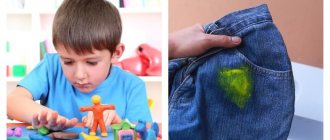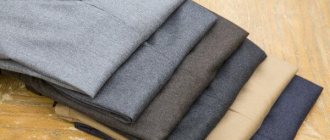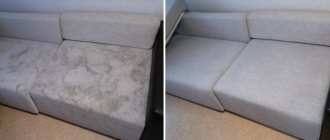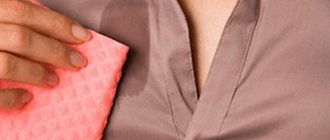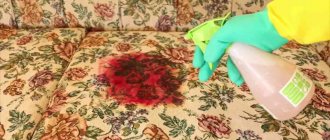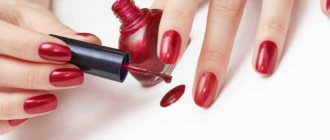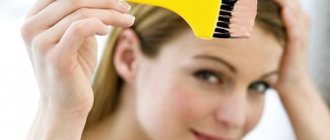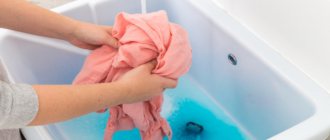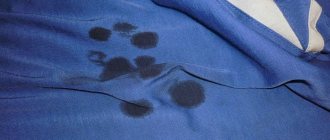In a house where there is a child or several children, there are always toys, books, paints, and, of course, plasticine, from which children love to make various crafts. Despite the fact that there are special boards for modeling, children often drop plasticine on carpets or furniture.
Mechanical methods
These are rather crude methods, the essence of which is basic scraping.
Cases when a stain can simply be scraped off are rare. Most often, additional means are used - soap, chemicals, water. You can use the following algorithm:
- In a small bowl, dilute a couple of tablespoons of shaved laundry soap in warm water.
- Add two pinches of baking soda to this mixture.
- Use a dish sponge to moisten and clean any remaining plasticine remaining after mechanical cleaning.
- Remove soap stains with a clean sponge and water.
Abrasive compounds
Abrasive compounds are in some ways reminiscent of mechanical ones, but in a more gentle version. Salt, crushed nut shells, and fine river sand work well.
Salt is the most gentle remedy; it is suitable for lightly stained fabrics and fabrics with minimal lint. Sprinkle plasticine marks on the upholstery with slightly moistened salt and wipe off the stain with a cloth.
You can take sea salt, since its particles are much larger and it is more convenient than food salt.
For more persistent plasticine stains, nutshells are suitable. Walnut shells are ground in a coffee grinder and sprinkled on the upholstery. A rag is soaked in water, squeezed out and the dirt is wiped off. Remaining stains can be cleaned with any cleaning solution.
Stubborn stains can be removed with fine river sand. This method will not work for fabrics with high pile, as this rather rough method can damage it. The breeding algorithm is the same as with the shell.
Cold cleaning
At low temperatures, plasticine loses its plastic properties and becomes brittle; this property is used to quickly remove plastic stains.
Note! The cold will help remove chewing gum and foam from clothes.
We act sequentially:
- Take a stick of butter, a piece of meat or chicken from the freezer and apply it to the upholstery for 3-4 minutes.
- Check how much the plasticine has cooled.
- If it has already become brittle, carefully clean it off the surface.
- If there is not enough time, we replace frozen products with new ones to continue exposure to cold.
- We remove as much as possible all remaining stains.
If necessary, treat the remaining stains with a soapy sponge until the marks disappear completely.
Advice! Do not use frozen berries to cool fabric surfaces, otherwise you will have to learn how to remove strawberry or cherry stains from fabric.
Glass hydrophobia
https://iloveremont.ru/wp-content/uploads/2019/11/ispolzuem-gubki-dlya-udaleniya-razvodov-e1512338961282-590×421.jpg"; alt=”Sponges for removing stains” width=590 height=421 We use special sponges for removing stains Excessively hard tap water can become the enemy of glass furniture. Removing her stains is not easy. Here are the basic tips that will help in this difficult matter:
For fresh stains, use special “magic eraser” sponges; special soap pads made of steel wool have worked well.
IMPORTANT! Forget about hard brushes and abrasive pastes - they leave scratches
Baking Soda Superpower
https://iloveremont.ru/wp-content/uploads/2019/11/pishchevaya-soda-dlya-udaleniya-pyaten-e1512338219299-590×422.jpg"; alt=”Baking soda” width=590 height=422 Baking soda for removing stains For heavily neglected surfaces covered with old hard water stains, first treat with vinegar, leave for half an hour, then rub with baking soda and remove any remaining dirt. As a radical remedy, use a paste of vinegar and soda.
The tooth fairy is resting
https://iloveremont.ru/wp-content/uploads/2019/11/ispolzuem-zubnuyu-pastu-dlya-ustraneniya-pyaten-e1512338091799-590×414.jpg"; alt=”Use toothpaste” width=590 height=414 Use toothpaste to remove stains on furniture Regular toothpaste will replace a too aggressive mixture of soda and vinegar:
- rub it with a damp towel over the surface of the stain;
- wait ten minutes;
- rinse with a water solution of vinegar.
Lemons in vinegar is a theme
Acetic acid and lemon juice are an excellent cleaning agent that does not leave streaks on glass furniture. Pour the mixture, slightly heated for half a minute, into a container with a spray bottle. Apply it to the glass and wait three minutes. Wipe with a lint-free non-woven cloth. https://iloveremont.ru/wp-content/uploads/2019/11/nanosim-limonnuyu-i-uksusnuyu-kislotu-e1512387689466-590×369.jpg"; alt=”Apply citric and acetic acid” width=590 height=369 Apply citric and acetic acid from a spray bottle NOTE! Ammonia can be added to any glass cleaner to enhance its properties.
The Kings Last Argument
https://iloveremont.ru/wp-content/uploads/2019/11/kisloty-primenyaem-s-bolshoj-ostorozhnostyu-e1512338546829-590×404.jpg"; alt=”Acid is a last resort” width=590 height=404 We use acids with great care If the methods described above did not help, the following will help your glass coffee table achieve enlightenment:
- sulfamic acid – soluble in water, does not require special disposal methods;
- hydrochloric acid – used in a concentration of no more than 15%;
IMPORTANT! If unprotected, these products cause severe skin burns and damage to the upper respiratory tract.
Careless use can damage your furniture. We hope that our tips for fighting stains will help you out in difficult times.
But if they don’t help, use the services of a cleaning company that specializes in professional cleaning of furniture and premises. https://iloveremont.ru/wp-content/uploads/2019/11/professionalnaya-chistka-mebeli-590×590.jpg"; alt=”Professional cleaning of furniture” width=590 height=590 Professional cleaning of furniture with special means https://iloveremont.ru/wp-content/uploads/2019/11/obnovlenie-staroj-polirovki-na-kresle-590×393. jpg"; alt=”Renewing the old polish on the chair” width=590 height=393 Renewing the old polish and removing dirt on the chair
We hope that our tips for dealing with stains will help you out in difficult times. But if they don’t help, use the services of a cleaning company that specializes in professional cleaning of furniture and premises. https://iloveremont.ru/wp-content/uploads/2019/11/professionalnaya-chistka-mebeli-590×590.jpg"; alt=”Professional cleaning of furniture” width=590 height=590 Professional cleaning of furniture with special means https://iloveremont.ru/wp-content/uploads/2019/11/obnovlenie-staroj-polirovki-na-kresle-590×393. jpg"; alt=”Renewing the old polish on the chair” width=590 height=393 Renewing the old polish and removing dirt on the chair
What to do: stains on upholstery
Cleanliness is an essential part of a happy home where people enjoy life. With furniture upholstery, this is only one aspect, but an important one.
Think about every time you ate on the couch and dropped food crumbs or spilled drinks that left stains. What can we say about dirty feet, dirty clothes or just daily wear and tear that can leave the upholstery dirty and gray. But all these stains don't have to become a black mark on your home's curb appeal.
The most important thing you need to understand is that upholstery is not the whole furniture, it’s just the fabric, and it’s just the fabric that needs to be cleaned.
If you are unsure, you can always check the manufacturer's information. Then, before you begin cleaning a large stain, we recommend testing the cleaner and cleaning method on a small, inconspicuous area of the upholstery to ensure there is no discoloration or other damage.
In this guide, in addition to basic cleaning tips and techniques, we'll look at the different types of stains you might encounter on your upholstery.
Oil stains
The whole family gets together to watch a movie, and with it comes hot popcorn full of butter on the couch. And while everyone is careful, pieces of popcorn may fall onto the sofa, after which you will find greasy stains on the upholstered furniture.
Against butter, the best option is a dry solvent, which you can find in a grocery or retail store. Apply a little onto a clean white cloth and blot the stain, but do not rub.
Next, mix one tablespoon of a mild, balanced detergent to one cup of warm water. Again, just blot the stain. Next, using another rag or towel, rinse off the solvent/detergent with warm water and allow the upholstery to dry.
Oil stains from cheese
Cheese is another food product that often ends up on upholstery. Again, it's found in all your favorite TV snacks, hence leaving stains on a regular basis.
- Mix one teaspoon of a mild, balanced detergent with one glass of warm water. Using a clean, white towel, blot the cheese stain.
- Finally, blot the stain with clean water to remove any remaining cleaning solution or chlorine.
- Allow the affected area to dry.
Ink stains on upholstery
Coming home from work or school, you throw your shirt on the sofa, the pen in your shirt pocket is leaking, but before you know it, there is a stain on the upholstery. Ballpoint pens, especially blue ones, are common stain makers, and we'll tell you how to deal with stains.
It is important, however, to remain patient and persistent, as ink stains can be stubborn. Just make sure you only blot the ink stains
Friction can cause the ink stain to grow larger.
You have several options, including:
- Spray hairspray onto a clean, white rag and blot the stain, then blot with a clean, dry rag.
- Use a white rag soaked in isopropyl alcohol. Again, blot the ink stain with it and then dry with a towel.
- Again use a clean white towel, but now you can use nail polish remover or acetone. Work the ink stain from the edges to the center.
- Commercial products that work well on ink stains include Carbona or AFTA. For both products, you'll need to use a clean, white towel to wipe down the affected area of the upholstery.
Coffee stains
Sipping coffee on a chair or sofa is a common occurrence. To get rid of a coffee stain, mix one teaspoon of a mild, pH-balanced detergent with one cup of warm water, then blot the inside.
You can also make your own stain blotting mixture by mixing a third cup of white vinegar with two-thirds cup of water. When finished, use a white towel to absorb excess liquid, stain, and cleaner.
Regular cleaning will help keep your upholstery looking attractive and odor-free, which makes all the difference. Generally, you can use a regular vacuum cleaner with an appropriate attachment to keep your furniture clean. Stains on upholstery are not the biggest problem, just remove dust and any contaminants regularly.
At the same time, you can enjoy your favorite sofa or chair without spending your hard-earned money on stains on the upholstery.
How to clean wallpaper?
However, it’s not just objects and clothes that can get dirty—children know a lot about this. If plasticine ends up on the wallpaper and you don’t consider it as a conceptual wall decoration, arm yourself with a few items to get rid of the stain as quickly as possible. If smooth fabrics are damaged, be sure to prepare the following:
- scraper;
- hair dryer;
- dry napkin;
- sponge and detergent.
First, try to carefully remove the top layer of plasticine using a scraper. There is no need to smear it, just scrape it off. After removing the top part of the dirt, connect the hair dryer. Use it to warm up the stain and then blot it with a napkin. You can repeat these steps several times in a row. In the case of wallpaper, a greasy stain may also remain after contamination with plasticine, so you need to use a sponge, first soaking it in a soap solution. Do not pour water on the stain or soak the sponge thickly. It is enough to moisten, squeeze and rub the stained area.
After this, it remains to dry the treated area with a hairdryer.
Dry cleaning or DIY cleaning?
An old greasy stain does not respond well to any type of cleaning done using non-professional household chemicals or folk remedies. The best solution in this case is to order dry cleaning of the sofa at home, during which professional chemicals based on organic solvents will be used.
You can try to do the job yourself, but remember that household stain removers often cause discoloration in the area of the upholstery to which they were applied. They do not contain organic solvents, which are found in professional products, which reduces the overall effectiveness of their impact on pollution.
Another problem is that after using stain removers, wet cleaning of furniture is recommended. During dry cleaning, residual water and chemicals are removed from fabrics using special equipment that is not available to household consumers. If you do not do this, you may encounter the following troubles:
- fungus and mold, because damp fabrics are the best environment for their reproduction;
- the appearance of an unpleasant odor;
- A large amount of dust will settle on the remains of a detergent that has a sticky base, so a stain will form again in this place. Your family members and pets will have to constantly inhale both dust and chemical components.
The use of different cleaning compounds leads to discoloration and stretching of materials, changes in the structure of the pile, which is why the upholstery looks worn out and unkempt.
Let's sum it up
We looked at recommendations on how to clean a greasy stain from a sofa, as well as their pros and cons
The choice of method is yours, but if you don’t want to accidentally damage the furniture through carelessness, then it’s better to seek help from professionals who specialize in dry cleaning. All work will be completed at your home in a few hours!
Do you want to know the cost of dry cleaning at home in Moscow?
Fill out the form and we will contact you within 5 minutes!
How to properly disassemble a computer mouse
It is best to clean the mouse from dirt if it is collapsible.
In this case, perform the following sequential actions:
- disconnect the mouse from the computer;
- The socket and wire are cleaned with a cotton swab soaked in alcohol;
- then prepare a special mat on which the mouse will be disassembled;
- turn the device upside down and use a Phillips screwdriver to unscrew the deepest screw;
- the body is separated into two parts;
- remove the chip, ball or laser sensor;
- take a scraper and clean off old dirt;
- Use soft damp cloths to wipe away any remaining dirt;
- All parts are thoroughly dried;
- at the last stage all that remains is to assemble the structure.
How to clean a sofa made of velor, fabric and leather
Gentle products are suitable for fabric sofas. Bleach and acids can cause fabric to become damaged or lose color. The best option is cleaning with a steam generator. It also gets rid of dust and odors.
Upholstered leather furniture needs wet cleaning. The back and seats are wiped with a damp cloth soaked in vinegar. Difficult stains on leather surfaces can be easily removed with soap.
The dry cleaning method is not suitable for velor sofas. Powders clog porous surfaces and spoil the appearance of furniture.
One of the processing options is to use a roller to remove pellets. Use it to remove dry dirt. For wet cleaning, prepare a liquid from soap and water mixed with a small amount of table vinegar. To clean velor, use a microfiber cloth. Sponges and brushes can damage the structure of the pile.
Be sure to read:
How to wash iodine: effective ways to remove stains from fabrics, what not to use
Features of pollution
Plasticine is a material that, due to its malleability, can take any shape. For its production, high molecular weight polyethylene, polyvinyl chloride and some types of rubber are used. All these components have the ability to leave greasy spots on various surfaces. It turns out that removing the plasticine itself will not be difficult, but removing greasy stains is problematic.
Plasticine easily heats up even at a low temperature - a touch of the hand can cause the material to melt, which will lead to it spreading over the surface. And due to the fact that it contains dyes, the greasy stain is formed with a certain shade, which makes the process of removing the mark even more difficult.
A few years ago, plasticine mass was made from clay powder, animal fats and substances that helped the material not dry out. And this, in turn, made it more stable, which made the process of removing it more difficult. Now any surface can be cleaned of plasticine so that absolutely no traces remain.
Use of chemicals
Car interior care products can also serve as an excellent home stain remover. A small educational program on how to do this:
- Spray the product on the dirty surface, or thoroughly saturate the plasticine stain.
- Wait for the reaction to occur.
- Remove any remaining dirt with a rag.
- Repeat several times.
Plasticine
Yes, yes, there is no mistake here. There is a good Russian proverb: “They knock out a wedge with a wedge.” So this is just about this case. You need to take a cube of white plasticine and stick it to the stuck piece. With a sharp movement, tear off the piece so that as much as possible of the one that originally stuck to the white plasticine comes off. When the plasticine is removed and only the stain remains, it can be easily wiped off with detergent.
Special stain removers
Dishwashing liquid together with a stain remover will help remove plasticine. Everything is simple here, you just need to follow the instructions on the package. A small amount of these products should be left on the plasticine stain for a few minutes, then the residue should be removed with a rag, from the edge to the center.
Solvents
Solvents such as gasoline, acetone or white spirit will help when cleaning a sofa from plasticine stains.
Very aggressive methods, the use of which requires maximum caution. Rubber gloves and a well-ventilated area are mandatory conditions for working with solvents, otherwise you can cause harm to your health.
The principle of operation is as follows: you need to moisten a cloth and wipe the stain several times. Care must be taken to ensure that flammable liquids do not erode the paint from the fabric, so be careful and do not rub too hard.
Kerosene
You can use kerosene, the main thing is that it is clean, without foreign impurities. To do this, rags are moistened in kerosene and vigorously act on the plasticine contamination several times.
How to clean plasticine from carpets and furniture?
If pieces fall, they can be easily collected, but if someone has already stepped on the plasticine or accidentally sat down, then the question immediately arises: how to clean plasticine from carpets and furniture?
Before you begin removing plasticine from the carpet, you need to remove everything that can be done by hand, but you must make sure that the plasticine is not smeared on the carpet surface.
Common methods for removing plasticine from a carpet surface
- If there is a stain left on the carpet, you need to cover it with a napkin and iron it with an iron heated to medium temperature.
- If you don't have an iron at hand, you can use a hair dryer as an alternative. When heated, the plasticine will melt and be absorbed into the napkin material.
- To remove the remaining stain, you can use gasoline, ammonia or acetone, which you can use to moisten a sponge or cloth and wipe the dirty area.
- To clean carpet from plasticine, you can use an ice pack, which must be placed on the contaminated area and left for a while. After hardening, the plasticine can be removed by removing it from the carpet surface piece by piece. This type of work requires time and painstaking work.
- To clean carpets from plasticine, you can use solvents, such as white spirit. The stain must be thoroughly treated with a sponge soaked in solvent and left for several minutes. Then we repeat the procedure, wiping the surface from the edge to the center. At the end of the procedure, you need to take a clean rag and remove any remaining dirt on the carpet.
- You can remove the top layer of plasticine from the carpet using a knife or nail file. After this, you need to treat the contaminated area with a solution previously prepared from laundry soap, and then carefully walk over the contaminated area using a damp cloth.
- Specialized products designed for car interior care have a good cleaning effect.
- Cleaning is carried out by applying a small amount of this product to a plasticine stain. Then we leave the carpet for several hours.
- During this time, the plasticine will have time to turn into a liquid state, after which it must be removed with a damp cloth.
Tips for removing plasticine stains
There are a number of useful recommendations that will make the process of removing plasticine from clothing, soft and hard surfaces easier. Let's list the main ones:
- You cannot remove modeling material from fabrics with your fingers, rinse with water, or wipe with napkins. Due to such actions, the sticky mass will only penetrate deeper into the fibers.
- Do not use sharp objects to scrape plasticine.
- Before using chemicals, it is recommended to test their effect on an inconspicuous area of the product. If the texture of the material changes, you will have to use another, more gentle cleaning method.
- You should only work with aggressive chemicals with the windows open and wearing gloves.
Note: If your child is interested not only in modeling, but also in drawing, then recommendations for removing gouache from things will come in handy. And with older children - on removing pen ink from school clothes.
And finally. In order not to be upset by the unpleasant consequences of children's creativity, it is better to initially accustom the child to carefully work with plasticine. And if traces of the sticky mass are still found on clothes, furniture, floors or walls, putting things in order using the described methods will be as easy as shelling pears.
photo 2: depositphotos.com/banprik
General recommendations
When using any chemical, you must follow basic safety rules - protect your respiratory system with a respirator, and the skin of your hands with clothing, long sleeves and thick gloves. Otherwise, there is a risk of irritation or burns. It is recommended to further protect the mucous membrane of the eyes by wearing glasses.
When treating the ceiling or upper parts of walls, it is worth protecting your hair and scalp by wearing a hat. Before using a finished chemical, be sure to study the instructions and treat only those surfaces for which they are intended.
Chemical cleaning
The selection of household chemicals is huge. Naturally, there are means for cleaning the sofa from plasticine.
Car care products
To clean stained furniture, you can use products designed for car interior care, such as Clean All.
Aerosols for car care at home
For this:
- According to the instructions, spray or saturate the stained surface.
- We give time for the reaction between the care product and the contamination.
- Wipe off the residue with a rag.
Don't forget to change wet wipes when they get dirty.
Stain removers
A household stain remover, thanks to its dissolving active ingredients, will help clean the plasticine from the sofa as carefully as possible.
Stain remover
Following the instructions on the package, leave a small amount of product on the stain for a couple of minutes and then carefully remove the residue, moving from the edges to the center.
Important! Contamination must be cleaned clearly and quickly so that the action of the active stain remover does not spoil the upholstery.
Using solvents to clean plasticine from a sofa
Applicable solvents are purified gasoline, white spirit and others.
These are aggressive agents, they must be used with caution, it is recommended to work with the stain using rubber gloves and in a ventilated area
Preventing stains
Restrictions and prohibitions on a child’s activities are not a method of education. A properly organized workplace is a guarantee of quick cleaning without consequences.
Equip the place for modeling with a comfortable table with a child's chair to eliminate the desire of your “Michelangelo” to move to the usual sofa.
With the advent of non-fat-based plasticine, the procedure for cleaning upholstered furniture has become simpler. Although, knowing the rules and methods of cleaning, you can deal with any stain, even from ordinary plasticine.
Interesting experiments on cleaning plasticine in the video:
Larisa, June 30, 2022.
Subscribe to the channel Modern Housekeeping in Yandex.Zen
Save and share information on social networks:
Discussions are closed for this page
How to remove a grease stain from a sofa
There are two ways to get rid of a greasy stain from a sofa:
- using available means;
- using household chemicals.
Depending on the size and age of the grease stain, both methods are quite effective, but some of them are not suitable for all types of materials. Therefore, when cleaning dirt, first of all, determine what material your upholstery is made of, and only then start cleaning.
Pile upholstery: chenille, velor, flock
Fresh stains on pile fabrics are removed in several ways:
- Sprinkle salt over the entire surface of the stain (you can use flavored sea salt) and leave for 30 minutes. It is able to absorb fat and leave no trace. Once the salt has taken effect, remove it with a vacuum cleaner or brush.
- Add 30 ml of lemon juice and 15 ml of ammonia to 1 liter of warm water. Use a cotton pad soaked in the solution to treat the stain. Next, take a small piece of cotton and wet it in the same way, then spread it over the entire contaminated area. After 1.5 hours, wipe with a soap solution based on laundry soap, rinse with clean water and dry.
Natural fabrics: cotton, jacquard, tapestry, matting
Natural materials are more demanding. They do not “like” intense friction, aggressive chemicals and prolonged exposure to water. To remove a greasy stain from a sofa made of natural materials, you must follow these steps:
- Apply one of the following products to a fresh greasy stain: soda, starch, chalk. Leave it like this for 10-15 minutes, then remove the powder with a vacuum cleaner with a soft attachment.
- One of the weirdest ways is to use shaving foam. Apply it to the stain and gently rub it with a brush. After 7-10 minutes, remove the foam with a paper towel, wipe the area with a clean damp sponge and dry the upholstery.
Upholstery made of leatherette, leather, vinyl
Removing a greasy stain from a sofa made of such smooth materials as leatherette, leather, vinyl is, in principle, the easiest task, but it also requires the most careful approach:
- Beat the egg white until a stable foam forms and apply the entire mixture to the stain. After 7-10 minutes, remove the product with a paper or damp cloth and rinse with clean water.
- Add 30 ml of lemon juice or vinegar to 1 liter of warm water. Rinse the entire problem area first with the resulting solution, and then with clean water. The upholstery should not be left wet, so the final step is to wipe the surface dry with a soft cloth (cotton or microfiber).
Primary treatment of soiled items
If you need to clean clothes from large pieces of plasticine, the freezing method will help. At sub-zero temperatures, the sticky substance will freeze and easily come off the fabric. To do this, put the clothes in a plastic bag and leave them in the freezer for 1-1.5 hours. Then carefully scrape off the hard grains with a plastic spatula, the back of a knife, or a wooden skewer.
If the plasticine has become deeply embedded in the fibers of the fabric, you need to use an iron. The task is this:
- The soiled item is turned inside out.
- Place paper napkins or toilet paper folded in 2-3 layers under and on top of the stain. The sheet of paper should be larger than the area of the iron sole.
- The iron is heated to 50 degrees and its sole is pressed against the clothing for 10–20 seconds.
- The manipulations are repeated several times, replacing used napkins with clean ones.
The procedure is completed when the stain is no longer imprinted on the paper.
Second thermal option: blow drying . In terms of efficiency, it is slightly inferior to cleaning with an iron and is used only to remove small dirt.
However, removing the bulk of the plasticine from clothes is not enough to completely put it in order. You will also have to wash off the grease and colored stains remaining from the sticky mass.
Cleaning with a hairdryer
This method is an effective and safe cleaning option. To make the result as pleasing as possible, you should adhere to the following sequence of actions:
- Try to quickly remove as much of the stuck mass as possible using another piece of light-colored plasticine.
- Cover the area with plasticine with a white paper handkerchief.
- Turn on the hairdryer and heat this area until the mass melts.
- Gently blot this area with a napkin.
- Wash off the remaining stain with a sponge soaked in a soap solution. Products with anti-fat formulas work well: Cif, Gold Vanish.
- You can use a hot iron with steam mode, or a steam generator. This method is only good for fabric coverings.
Temperature effect
Modeling mass has an interesting physical property - it changes structure under the influence of temperature.
In the cold, plasticine loses its plasticity and becomes hard. Its melting point is low, so when it comes into contact with hands, heating devices and warm air, it practically “floats”. This property can be used by the hostess. First method (cold):
- Place the product in the freezer.
- Wait until the mixture hardens (no more than 20 minutes).
- Tear off the cake using tweezers.
It is not recommended to separate the plasticine with your hands; it may melt again. If the surface is large, for example, a carpet, you can use ice cubes for freezing.
Second method (hot):
- Spread the product on a flat surface.
- Cover the stain with a thick sheet of paper.
- Iron with a heated iron until the mass sticks to the sheet.
Article on the topic: How to glue vinyl stickers on furniture
Both methods involve subsequent washing to remove the greasy mark from the plasticine cake and treating the affected area with special products.
Thermal cleaning method
To clean the surface using a hair dryer, follow the following sequence for cleaning upholstered furniture:
- Try to remove as much of the mass stuck to the sofa as possible using sharp movements using another piece of white plasticine.
- Cover the stained area with a white paper napkin.
- Turn on a household hair dryer and heat the area until the mass softens.
- Lightly blot the stain with a white napkin.
Removing stains with a hairdryer
Gently wash the remaining stain with a sponge and soapy water. It is advisable to use grease-dissolving products for kitchen surfaces, for example, Cif, Vanish Gold.
A hot iron also helps remove plasticine from the sofa quickly and accurately due to the heat. But this method is only suitable for cleaning fabric coverings. It is better to use a steam iron or steam generator.
To remove stains from fabric sofas:
- Cover the stained area with a light paper napkin.
- Lightly iron the surface of the sofa with an iron heated to 50–60 degrees. If you use a steam generator, apply steam until the plasticine softens.
- Carefully remove the stain from the surface with another napkin, similar to the method with a hairdryer.
- It is necessary to change the napkins until the marks on the upholstery fabric completely disappear.
Important! The area of the napkin to remove a stain should be larger than the dirt
Removal from textiles
It’s still not difficult to remove wax and other components of plasticine from plastic and wood, but what to do if the clothes are damaged? First, remove the top layer with a plastic knife or any other similar object. Then you can use two contrasting but effective methods: cooling or heating. The first will reduce the sticky properties of plasticine, and it will be better separated from the fibers of the fabric. Options for freezing things:
- Packed in plastic, put in the freezer;
- apply ice cubes to the stain;
- Apply a special cooling spray.
After this procedure, the plasticine stain will harden and can be cleaned off with a plastic knife or a stiff brush.
When you don't want to freeze your hands, turn on the iron. If the plasticine components froze using ice, the heating device will melt them. This method will help solve the problem on thick fabrics, such as jeans or trousers. To do this, you need to take several paper napkins and place one under the stained area, and the second above the fabric.
Without turning on the steam effect, you need to iron the napkin a couple of times, as a result of which the plasticine will remain on it.
Treatment with detergents
Plasticine is a fatty material. Therefore, fatty stains remain on the sofa after contact with it.
Greasy marks can be easily removed with soap
If the stain is small and there is only a trace (track) of plasticine on the upholstery, use detergents or soap:
- In a small volume, dilute two tablespoons of laundry soap shavings in warm water.
- Add half a teaspoon of baking soda.
- Using a household sponge soaked in a soapy solution, clean the plastic mass from the surface until all traces of contamination disappear.
Finally, use a clean, damp sponge to remove any traces of soapy water.
Tips for parents
You can avoid problems with plasticine sticking if you use some simple tips:
- Set aside a special place for creativity.
- Provide your baby with clothes that you don’t mind getting dirty.
- Do not leave the child alone while sculpting.
- After playing, remove materials and instruments to a specially designated storage area.
There is an option for “lazy” parents - buying plasticine in plastic containers. It does not leave stains, does not stick to surfaces and dries with prolonged contact with air. It has disadvantages - a short period of use and the price is much higher.
Traditional methods
At home, affordable and easy-to-prepare means are used for self-care of fabric material.
Having chosen a care composition, you need to carefully study the recipe for its preparation and the specifics of its use. If you use this folk remedy correctly, you can get excellent results.
Laundry soap
One of the most popular products is laundry soap. Effectively removes dirt, returning furniture to a tidy state. For cleaning, take dark laundry soap, the bar of which says 72%.
How to use:
- You need to take a piece of the product and dissolve it in warm water. To quickly prepare a soap solution, part of the bar can be grated on a fine grater.
- A soft brush or sponge is soaked in the resulting liquid, the excess is squeezed out and the problem areas of the skin begin to be carefully cleaned.
- At the end of the work, wipe the cleaned areas with a clean, dry cloth to remove excess soap.
Pros:
- cheap;
- Just;
- Suitable for cleaning fleecy fabrics;
- soap does not leave a characteristic odor on the fabric;
- does not cause allergies, so it is used in homes where children live.
Cons: Doesn't work on old stains.
Dishwashing liquid
Dishwashing detergent contains degreasing components that help eliminate grease and organic stains. The product is used to clean a tapestry sofa.
How to use:
- A few drops of detergent are added to the water and foam is whipped on the surface of the liquid.
- A small amount of foam should be placed on the area requiring cleaning.
- You need to wait 5-10 minutes.
- Contaminants are carefully rubbed with a soft brush.
- Use a dry cloth to remove any remaining detergent.
Pros:
- getting rid of greasy stains;
- quick and easy method.
Minuses:
- a solution that is too concentrated will leave streaks on the fabric;
- Not suitable for all types of cladding.
Soda
A universal product that removes unpleasant odors and dirt. There are several effective ways to clean a fabric sofa with baking soda:
Method Detailed description Features Dry cleaning The fabric or some areas of it are thickly sprinkled with baking soda powder. The sofa is left in this state for an hour. After an hour, the soda is removed with a vacuum cleaner. There is no need to rub or wet the cloth. It is used to care for upholstery that is not recommended to be cleaned with wet compounds. Wet cleaning A clean sponge is soaked in water, wrung out and wiped over the upholstery. After moistening, the material is generously sprinkled with soda.
After half an hour, take a soft brush and treat the fabric, paying special attention to heavily soiled areas. The sofa needs to be allowed to dry
Then take a vacuum cleaner and remove the remaining soda powder. If soda remains, you need to remove it with a damp cloth. Used when dealing with crowding and dark spots. Using soda slurry Soda and water are mixed strictly in equal proportions. The resulting mass is evenly distributed over the entire surface of the sofa. The product should be rubbed into the fabric with a soft brush and left for an hour. After this time, it is necessary to vacuum the upholstered furniture. Excess soda is removed with a damp cloth. Application of the method requires a minimum of 2 hours. If the sofa is wide, you will need a large amount of soda. Soda + detergent You need to take a basin and fill it with a liter of water. Add 2 tablespoons of dishwashing detergent and soda to the liquid. The solution must be thoroughly foamed. Apply foam to the surface of the material. The product is left for 5-10 minutes. Wipe dirty areas with a brush. Dirty foam must be washed off with clean water. It is used if the sofa has severe dirt and stubborn stains. An excellent remedy for urine odor. Soda + vinegar Add 1 tablespoon of soda to a liter of water. The composition is poured into a spray bottle and sprayed onto the sheathing. When the fabric is dry, it needs to be carefully vacuumed. The next step is preparing a vinegar solution from a tablespoon of essence and a liter of water. The composition is sprayed onto the material and wait for it to dry. The method will help cope with the unpleasant odor. When working with vinegar, you need to ensure access to fresh air in the room.
Cleaning clothes from greasy plasticine stains
After freezing or heat treatment, when it was possible to clean school pants, skirts and other clothes from the main mass for modeling, all that remains is to remove the remaining greasy mark.
To do this, you can use stain removers or pre-cleaning spray. Things are first treated with the chosen product, washed and machine washed.
From trouser and other fabrics
Kerosene . Items made from natural cotton material, such as jeans, can be treated with household solvents. To remove stains, you can use white spirit, purified kerosene, an aqueous solution of ammonia (10 drops per 250 ml of water), and acetone.
The procedure is carried out according to the following scheme:
- a little solvent is dripped onto the contaminated area;
- wipe the trace of plasticine with a sponge from the edges of the stain to the center;
- leave for 15-20 minutes;
- rinse under running water.
Vegetable oil and soda . After ironing, it is easy to remove plasticine from black trousers, jackets, and school uniform skirts with regular vegetable oil. You need to do the following:
- The sponge is soaked in oil.
- Wipe the stained area until the last drop of plasticine disappears.
- The resulting oil stain is filled with dishwashing gel.
- Leave for half an hour.
- Rinse the item in lukewarm water and wash.
To enhance the effect, residual stains are treated with a slurry of ordinary baking soda. The mixture is rubbed into the fabric fibers with a stiff sponge or toothbrush. Leave for 10 minutes. Rinse.
After cleaning, the product is always washed in the temperature mode intended for the specific type of fabric.
Stain removers . Synthetic fabric requires delicate handling. To clean oil stains and colored stains on clothes made of artificial materials, it is better to use dishwashing detergent (Fairy, etc.), oxygen-containing stain remover (Vanish, Antipyatin, etc.).
Leather
Removing stains from leather furniture is not a very difficult process. The main thing is to use only soft sponges and products without abrasive particles, so as not to damage the material.
We suggest you familiarize yourself with How to properly wash jeans by hand: can they be washed with other things?
Fresh stains can be easily removed with a damp cloth. If the contamination has already dried, you can use one of the following methods:
- Ammonia and glycerin. This mixture will remove dark ink stains on light skin. It cannot be used on colored or black surfaces - a noticeable whitish mark will remain. Ammonia in pure form or with the addition of a small amount of glycerin is applied to the blackened area and left for several minutes. Then remove the residue with a damp sponge.
- Milk. Suitable for white leather upholstery. Wipe the problem area with a cotton pad soaked in milk. This method can be used not only to remove stains, but also to refresh the color of the material.
- Ammonia or weak vinegar solution (for light skin). Moisten a soft cloth with one of the liquids and wipe off the greasy stain. Afterwards, treat the cleaned area with vegetable oil (castor, sunflower, linseed) and polish with microfiber or suede. This is necessary to protect the material from cracks.
- Talc or starch. Used to remove traces of oil from skin of any color. Sprinkle the stain generously with powder and leave for several hours. When the talc absorbs the dirt, it is cleaned with a soft cloth. Wipe the leather upholstery first with soapy water and then with a clean damp cloth.
- Soap solution. Effective against darkened blood stains. Gently treat the stain with a damp soapy sponge and then wipe with a dry cloth.
How to wipe plasticine off the table
The working area for future plasticine masterpieces always gets dirty first. To keep your furniture looking beautiful, we will share several effective methods.
Under no circumstances should plastic furniture be heated with an iron or hairdryer. Plastic is a very sensitive material. Even if you remove the plasticine, the stain will still remain. It’s better to take something cold out of the refrigerator and apply it to the problem area on the table. Then scrape off the frozen plasticine with a thin, blunt object. Rinse the table with warm water and wipe the work area with a dry cloth.
How to wipe plasticine off the table
- A wooden table can be revived with vegetable oil. Wet plasticine stains or dried lumps with vegetable oil. Let the oil and plasticine soak for 5 minutes, then carefully remove the Velcro with dry wipes. Wash the table with warm water.
- If there are stains from art left on the table, you need to treat them additionally. Take hydrogen peroxide, moisten a cotton pad with it, and degrease the stains. Then wipe the traces of the plastic mass with alcohol or vodka, the greasy stains will disappear.
To ensure that the table suffers from plasticine captivity as little as possible, buy a protective film or a special board for modeling for the table.
